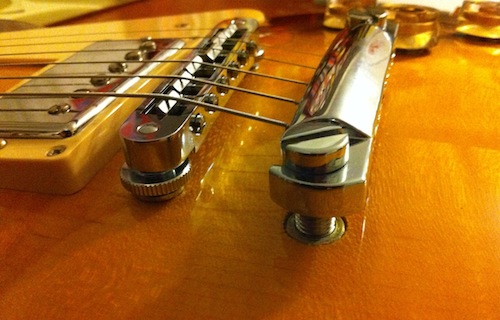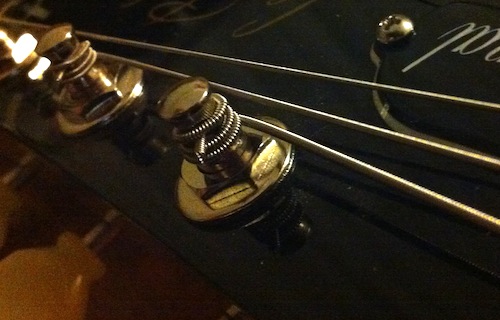Modern Saint
Starve your Fear, Feed your Dream!
For some reason I was curious and decided to look into it. I have done both method of tailpiece restringing and found that I like the wrap around more.
Guitar starts with the string. Woods are important; so is the neck profile, the fretboard radius, the neck joint, the fret finishing and the electronics. But none of that would mean anything without a well-crafted string. The player interacts with the string via their pick and fretting hand, then the string interacts with the pickup by disturbing its magnetic field, and then after the sound has worked its way through an amplifier and speaker, that same energy pushes the string to greater heights of sustain. Here are a few tips to get the most out of your strings, especially if you use a Les Paul-style guitar.
Regular Tailpiece Stringing
Most Les Pauls leave the factory with their strings passing through the tailpiece from the back, as the system was originally designed. This is a nice low-maintenance method that ensures good transfer of energy from the string to the tailpiece and into the body.

If you wish to keep your guitar strung this way, the only thing to really be mindful of is to ensure a straight path for the string to travel between the bridge saddle and tailpiece. If the string touches the edge of the bridge itself after passing over the saddle, simply raise the tailpiece just enough for the string's path to be straightened out. Some players prefer to set the tailpiece as high as they possibly can without the string popping out of the saddle. Depending on how high or low you set your tailpiece you may perceive a change in string tension too: some players feel that a higher tailpiece provides a slightly 'looser' playing feel. Feel free to experiment with the height on each side of the tailpiece. A popular method is to have the bass side set lower for a tighter feel on the low strings.
Top Wrapping
There's another way to string a Les Paul tailpiece, and it's a method that ZZ Top's Billy Gibbons is so fond of that theGibson Custom Billy Gibbons "Pearly Gates" Les Paul Standard arrives with this feature right out of the box: top wrapping. This is when the strings are passed through the tailpiece from the pickup side, rather than from the rear strap button side. The strings are then curved back over the tailpiece and passed over the bridge saddles in the usual way.

There are two main reasons some players prefer this method. For starters, it provides a shallower break angle over the bridge saddle, since the strings pass from the top of the bridge instead of halfway through it, and many players report that their strings feel slinkier as a result. Secondly (and perhaps most importantly for most guitarists) this allows you to screw the tailpiece all the way down against the body, which many players feel gives the guitar more sustain and fullness. Zakk Wylde is another famous top-wrapper.
Tuning Pegs
Here's a method that improves tuning stability for most players (unless your guitar has locking tuners like those found on the 2012 Gibson USA Les Paul Standard). It's the way most guitars arrive from factories, but many players don't maintain it during the first restringing. Here's what it looks like:

First, make sure the first winding of the new string around the tuner post goes over the exposed tip of the new string. The rest of the winding should then go under the exposed tip of the string. When you tune the string to pitch, the pressure between the first 'over the top wrap' and the lower wraps keeps the exposed string tip clamped firmly and prevents it from slipping around the tuner post. This will benefit your tuning stability throughout the life of the string, but the advantage is particularly evident immediately after stringing (Gibson recommends at least five turns around the post for unwound strings, and two or three for wound strings). It's typical and recommended to stretch each string immediately after installing it, and you'll find that the string settles into its intended pitch much sooner than if you simply feed all of the string through below the string tip without performing the lock trick.
http://www.gibson.com/News-Lifestyl...ere-s-More-Than-One-Way-To-String-An-Axe.aspx
Guitar starts with the string. Woods are important; so is the neck profile, the fretboard radius, the neck joint, the fret finishing and the electronics. But none of that would mean anything without a well-crafted string. The player interacts with the string via their pick and fretting hand, then the string interacts with the pickup by disturbing its magnetic field, and then after the sound has worked its way through an amplifier and speaker, that same energy pushes the string to greater heights of sustain. Here are a few tips to get the most out of your strings, especially if you use a Les Paul-style guitar.
Regular Tailpiece Stringing
Most Les Pauls leave the factory with their strings passing through the tailpiece from the back, as the system was originally designed. This is a nice low-maintenance method that ensures good transfer of energy from the string to the tailpiece and into the body.

If you wish to keep your guitar strung this way, the only thing to really be mindful of is to ensure a straight path for the string to travel between the bridge saddle and tailpiece. If the string touches the edge of the bridge itself after passing over the saddle, simply raise the tailpiece just enough for the string's path to be straightened out. Some players prefer to set the tailpiece as high as they possibly can without the string popping out of the saddle. Depending on how high or low you set your tailpiece you may perceive a change in string tension too: some players feel that a higher tailpiece provides a slightly 'looser' playing feel. Feel free to experiment with the height on each side of the tailpiece. A popular method is to have the bass side set lower for a tighter feel on the low strings.
Top Wrapping
There's another way to string a Les Paul tailpiece, and it's a method that ZZ Top's Billy Gibbons is so fond of that theGibson Custom Billy Gibbons "Pearly Gates" Les Paul Standard arrives with this feature right out of the box: top wrapping. This is when the strings are passed through the tailpiece from the pickup side, rather than from the rear strap button side. The strings are then curved back over the tailpiece and passed over the bridge saddles in the usual way.

There are two main reasons some players prefer this method. For starters, it provides a shallower break angle over the bridge saddle, since the strings pass from the top of the bridge instead of halfway through it, and many players report that their strings feel slinkier as a result. Secondly (and perhaps most importantly for most guitarists) this allows you to screw the tailpiece all the way down against the body, which many players feel gives the guitar more sustain and fullness. Zakk Wylde is another famous top-wrapper.
Tuning Pegs
Here's a method that improves tuning stability for most players (unless your guitar has locking tuners like those found on the 2012 Gibson USA Les Paul Standard). It's the way most guitars arrive from factories, but many players don't maintain it during the first restringing. Here's what it looks like:

First, make sure the first winding of the new string around the tuner post goes over the exposed tip of the new string. The rest of the winding should then go under the exposed tip of the string. When you tune the string to pitch, the pressure between the first 'over the top wrap' and the lower wraps keeps the exposed string tip clamped firmly and prevents it from slipping around the tuner post. This will benefit your tuning stability throughout the life of the string, but the advantage is particularly evident immediately after stringing (Gibson recommends at least five turns around the post for unwound strings, and two or three for wound strings). It's typical and recommended to stretch each string immediately after installing it, and you'll find that the string settles into its intended pitch much sooner than if you simply feed all of the string through below the string tip without performing the lock trick.
http://www.gibson.com/News-Lifestyl...ere-s-More-Than-One-Way-To-String-An-Axe.aspx


